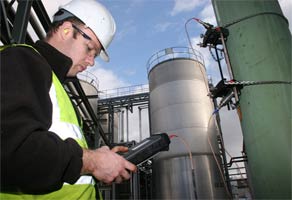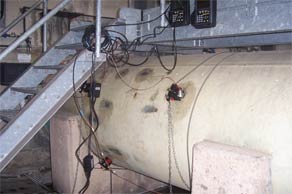Ultrasonic Flow Meter to Undertake Trunk Mains Verification
Abstract
A large water company in the UK had a long series of large trunk mains with permanent electromagnetic flow meters already in place. In order to maintain accurate flow readings RS Hydro were asked to verify the flow rates.
Equipment Used
The Panametrics PT878 portable flow meter.
The Specifications
- 1000mm stainless steel trunk mains
- Bitumen liner
- Verification required for existing electromagnetic flow meter.
The Solution
 On this occasion, RS Hydro needed to use an instrument which could monitor flow rates with out the need to cut into or modify the pipe work. To solve this problem, RS Hydro used ultrasonic technology, namely the Panametrics PT878. As this is a clamp on flow meter, the meter to be tested did not have to be removed in order to be verified.
On this occasion, RS Hydro needed to use an instrument which could monitor flow rates with out the need to cut into or modify the pipe work. To solve this problem, RS Hydro used ultrasonic technology, namely the Panametrics PT878. As this is a clamp on flow meter, the meter to be tested did not have to be removed in order to be verified.
As this application did not have perfect installation conditions, RS Hydro installed two PT878s, and used a technique called twin channel averaging to help reduce inaccuracies when data was analysed.
Our engineers set up the PT878s and left them for 24 hours to record the flow data. Once the data logging period had finished, the flow meters were uninstalled, and stored data was downloaded to a computer using the infrared port. The data from both instruments was converted into Excel spreadsheets and the average for each data point was taken. The data from the verification tests was then presented to the water company who were able to make comparisons between the data collected and data from their own meter.
From these comparisons they were able to prove that the Meter Under Test was working well within accuracy limits.
How it Works
 Transit time clamp on flow meters, such as the PT878, use the difference in time for an ultrasonic pulse to travel with the direction of flow and against it. When the velocity is zero, the transit time of an ultrasonic pulse is the same in both upstream and downstream directions. With flow, the upstream sonic pulse will travel at a slower rate that of the downstream pulse. When flow rates increase further, this transit time differential increases linearly. As the cross-sectional area is already known, the product of the velocity (transit time differential) and area equates to a volumetric flow.
Transit time clamp on flow meters, such as the PT878, use the difference in time for an ultrasonic pulse to travel with the direction of flow and against it. When the velocity is zero, the transit time of an ultrasonic pulse is the same in both upstream and downstream directions. With flow, the upstream sonic pulse will travel at a slower rate that of the downstream pulse. When flow rates increase further, this transit time differential increases linearly. As the cross-sectional area is already known, the product of the velocity (transit time differential) and area equates to a volumetric flow.
